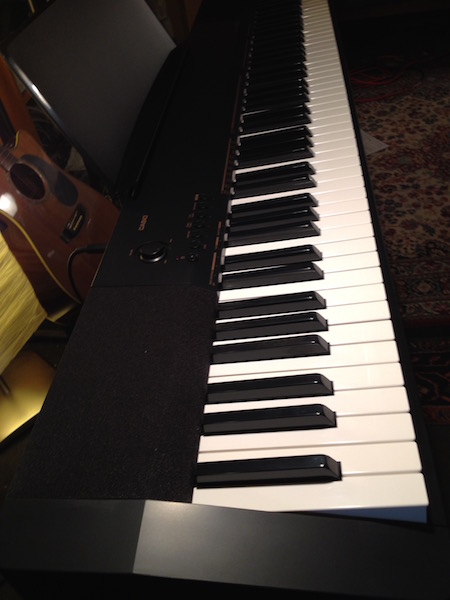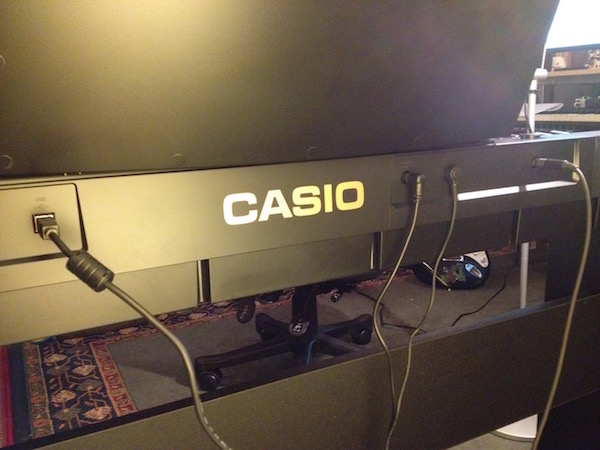 For a while, some people had the perception that Casio products are not quite ready for the “big time.” They had a couple of brushes with notability in the ‘80’s with the CZ line of synthesizers, but haven’t seemed to make any significant waves since. That being said, they may just be the dark horse in the race on some fronts—notably the digital piano realm. They’re a big company and produce a very deep range of products. Just browsing the Electronic Musical Instrument section of their website will back this up.
For a while, some people had the perception that Casio products are not quite ready for the “big time.” They had a couple of brushes with notability in the ‘80’s with the CZ line of synthesizers, but haven’t seemed to make any significant waves since. That being said, they may just be the dark horse in the race on some fronts—notably the digital piano realm. They’re a big company and produce a very deep range of products. Just browsing the Electronic Musical Instrument section of their website will back this up.
I’ve delved into the digital piano realm on the Plug-in blog a couple of times (Digital Pianos have come a long way … and ). It was only a year or so ago that folks were heralding the arrival of the sub-4-figure digital piano and now we’re looking at decent models that are under $500.
I had just one of these pianos, the Casio CDP-130CS delivered to my doorstep to review. It’s not a light piece of equipment, so make sure you’ve got a friend to help you move it or make sure that you’ve been keeping up with that gym membership for the past few months.
It comes packaged in two boxes:
- the instrument and accessories (music stand, damper pedal and power cord)
- the stand
I’ve included a sped up video of my unboxing and assembly adventures. It’s not incredibly difficult to put together—if you’ve successfully followed the instructions to build an Ikea shelf, then you should have no problems with this endeavour.
Riveting Casio CDP-130CS Unboxing Video:
Riveting Casio CDP-130CS Stand Assembly Video:
 The Specs and Features
The Specs and Features
The CDP-130CS comes from Casio’s Contemporary Digital Piano line. The piano itself is about 132cm long, 29cm deep and 13cm high. All in all, as compact as you can get for a piano that can fit somewhere in their office, living room, or bedroom. As I mentioned above, it’s not the most portable of keyboards. The piano weighs about 11 kg, which isn’t too bad, but if you’re planning on carrying it frequently it could get to be a pain.
The keyboard is an 88 note Scaled Hammer Action Keyboard which essentially means that Casio is trying to replicate the feel of a grand piano keyboard which requires a bit more force for lower notes and is a bit more forgiving in the upper register.
 There are three touch responsive sensitivity levels, 10 reverbs, 5 chorus tones and 10 keyboard tones (2 grand pianos, 3 electric pianos, harpsichord, vibraphone, strings, pipe organ and jazz organ) to choose from.
There are three touch responsive sensitivity levels, 10 reverbs, 5 chorus tones and 10 keyboard tones (2 grand pianos, 3 electric pianos, harpsichord, vibraphone, strings, pipe organ and jazz organ) to choose from.
The sound engine is Casio’s AHL Sound Source which apparently stands for “Acoustic and Highly compressed Large waveform”. As opposed to their modeling AiR sound engine used on some of their more expensive models, the AHL sound engine uses compressed recorded samples of acoustic instruments.
There is a maximum polyphony of 48 notes and with the layering function enabled, that decreases to 24.
The CDP-130CS includes fine tuning (A4=415.5 to 465.9Hz) and a 25-step transposition option (-12 to +12 semitones).
The amplifier and speakers are 8 Watts each and mounted at either end of the keyboard.
There is a USB port that lets you connect the CDP-130CS to a computer or other device to transmit MIDI data, letting you use the piano as a keyboard controller. The CDP-130CS is a class-compliant device which means that the piano is a plug-and-play device on most modern operating systems.
Playing the CDP-130
For the price that you pay for this keyboard, it’s going to take you a long way. Gone are the days where the price of a piano is a huge barrier to deciding whether or not to start piano lessons. You’re probably going to outgrow this keyboard well before you take that audition for Juilliard, but a CDP-130 is going to be something that will last you well into your piano education.
The sound of the keyboard is quite good considering that these are compressed audio samples being played back. You don’t get the advanced nuances that more expensive digital pianos try to emulate such as sympathetic string resonance (other strings and components of an acoustic piano vibrating as a result of another key being pressed) or string dampener noise (the sound of the dampening pads lifting and falling back on the strings). But I wouldn’t have expected those detailed elements either.
Run-Through of Casio CDP-130CS Video:
The keyboard feel is not bad either. It has a good resistance and a nice “clunk” that’s reminiscent of a lighter-action keyboard you might find on Yamaha or Baldwin acoustic pianos. The action is a little slow on the rebound, so if you’re itching to play Billy Joel’s “Angry Young Man,” you might have to adjust your playing style.

I wouldn’t have minded having some sort of LED read-out or display though. When doing tuning, transposing or metronome BPM settings, you’re kind of flying blind.
Wrap Up
Pianos and affordability, up until now, have been terms you’d never see together. The price-performance ratio is hard to beat on this piano—you really can’t go wrong. It is a solid product with a good feature set that will enable the beginner or intermediate player to really enjoy the instrument. If you’ve been wanting to take up piano or you’ve been looking for a reason to buy a piano and cost has been a factor, check out the CDP-130CS at Best Buy Canada.



